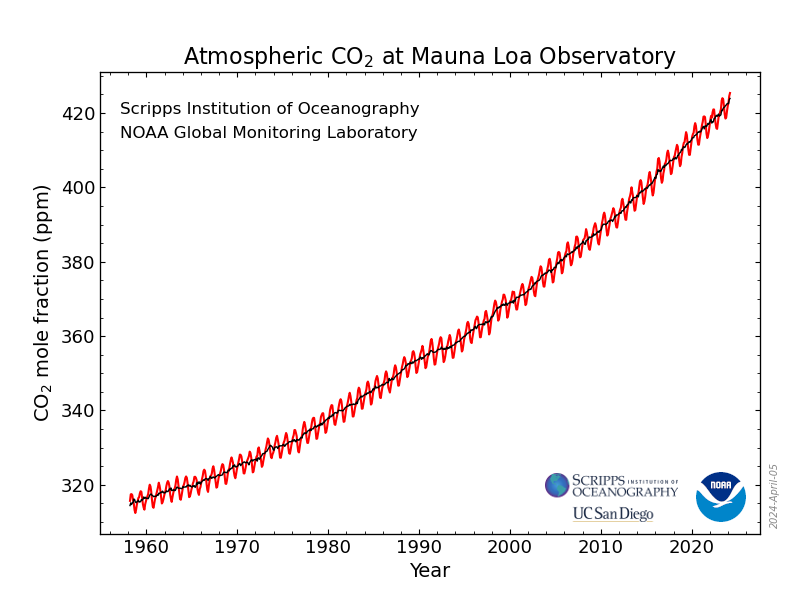Science
Related: About this forumThe CO2 Concentrations at Mauna Loa are 25.91 ppm higher than 10 years ago.
As I've indicated repeatedly in my DU writings, somewhat obsessively I keep a spreadsheet of the weekly data at the Mauna Loa Carbon Dioxide Observatory, which I use to do calculations to record the dying of our atmosphere, a triumph of fear, dogma and ignorance that did not have to be, but nonetheless is, a fact.
Facts matter.
When writing these depressing repeating posts about new records being set, reminiscent, over the years, to the ticking of a clock at a deathwatch, I often repeat some of the language from a previous post on this awful series, as I have been doing here with some modifications. It saves time.
A recent example of posts here relating to this disturbing habit of mine is this one: New Weekly CO2 Concentration Record (Provisional) Set at the Mauna Loa Observatory, 424.63 ppm.
This week's is unsettling, but then again, most weeks give unsettling data; the concentrations continue to rise at a rate that is accelerating, all the reactionary bullshit about the so called "renewable energy," batteries and hydrogen notwithstanding.
The planet is burning.
This week's readings:
Weekly value from 1 year ago: 418.81 ppm
Weekly value from 10 years ago: 396.39 ppm
Last updated: December 17, 2023
Weekly average CO2 at Mauna Loa
As noted in previous posts, the fact that this week's reading is lower than the record from last spring is a function of sinusoidal seasonal variations:

Monthly Average Mauna Loa CO2
This week's reading 422.20 ppm compared to last year's 418.81 ppm is "only" 3.39 ppm higher, which in the 20th century would have seemed outrageous but is now, regrettably, not all that dramatic.
As of this reading, there are 2,497 weekly readings that can be accessed at the Mauna Loa website; 3.39 ppm is "only" the 104th highest, in the 95th percentile.
Of the top 50 weekly readings, 40 occurred in this century, with 6 others taking place in 1998, when fires set in Southeast Asia to clear rain forest for palm oil plantations to supply "renewable biodiesel" to Germany went out of control because of drought, making 1998 the worst year for accumulation of CO2, at least until 2016.
This should have said something about the reactionary impulse to return to the 19th century and make energy supplies dependent o the weather, precisely at the time we have drastically destabilized the weather by not doing anything meaningful about climate change, but it didn't do so.
What is notable about this week's reading is that it is 25.81 higher than the reading of the same week 10 years ago.
Of the top 50 comparator's of weekly readings compared week-to-week with those of the same week 10 years ago, this is the 7th highest.
All of the top 50 such comparators have occurred since 2019, six of them in that year, the rest since and including 2020.
A 52 week running average of all comparators of concentrations of the dangerous fossil fuel waste CO2 in the planetary atmosphere in the past year is currently 24.35 ppm/10 years = 2.44 ppm/year. In the week 49 of the year 2000, the week beginning December 3, 2000, that running average was 15.19 ppm/10 years - 1.52 ppm/year.
We spent over 3 trillion dollars in the period between 2004 and 2019 rendering wilderness and farmland into industrial parks for wind and solar energy. Many here and elsewhere may think that this was "doing something." All this proves that people can lie to each other and lie to themselves, but that numbers don't lie. The effort to address climate change with wind and solar energy is obviously a grotesque failure, in particular because the reactionary impulse to employ so called "renewable energy" was originally never about climate change, but was rather about attacking the last best hope of humanity, nuclear energy. The obviously delusional belief that solar and wind energy have something to do with addressing climate change was and is an afterthought.
Source:
I manually entered the figures in the bar graph in figure 8 to see how much money we've thrown at this destructive affectation since 2004 (up to 2019): It works out to 3.2633 trillion dollars, more than President Biden has wisely recommended for the improvement of all infrastructure in the entire United States.
Have a nice day.